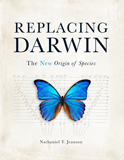Evolution’s Surprising New Critics
Prominent scientists are speaking out against Darwinian evolution, and they’re not even creationists. New findings are raising more questions than answers for the standard Darwinian view, and even evolutionary scientists find it difficult to ignore the implications.
Most people, both Christians and non-Christians alike, would be surprised to learn that all is not well in the land of molecules-to-man evolution. Creationists aren’t the only ones questioning the reigning evolutionary model—a band of rebellious evolutionists is leading a new movement called The Third Way.
As their website explains, “The vast majority of people believe that there are only two alternative ways to explain the origins of biological diversity. One way is Creationism that depends upon intervention by a divine Creator. . . . The commonly accepted alternative is Neo-Darwinism, which . . . invokes a set of unsupported assumptions. . . . Many scientists today see the need for . . . novel scientific thinking about the evolutionary process.”
This rebellion among the academic faithful is eliciting harsh responses from hardcore evolution promoters like Jerry Coyne, who expressed his frustration in a blog: “I am irritated by the constant appearance of what I call ‘BIS’—the Big Idea Syndrome.” He goes on to explain, “An evolutionist finds a new phenomenon, say transposable elements, or epigenetics, or ‘modularity,’ and suddenly that one phenomenon becomes the centerpiece of a claim that modern evolutionary theory is ripe for a revolution.”1
One of Coyne’s targets is Massimo Pigliucci, a leader in the rebellion who replied in a tit for tat, “Talk of an Extended Synthesis isn’t ‘any old claim’; it is a serious discussion among credentialed scientists. . . . At some point Coyne, Lynch [another famous evolutionist], and others need to do a bit more than just shake their heads and play armchair curmudgeon.”2
While these heated exchanges are entertaining and enlightening, the truth is, decades of scientific discovery have revealed numerous complex cellular systems that enable creatures to develop, grow, and adapt. These discoveries show no sign of having evolved bit by bit through chance evolutionary processes.
The all-or-nothing complexity of these amazing systems, which we are only just beginning to understand, speaks emphatically of design by an omnipotent Creator. And the latest biological discoveries are doing nothing to help the cause of the evolutionary faithful (either the old guard or the recent “Third Wave” rebels).
A Facade of Unity
Secular scientists have debated the grand idea of evolution—and how it might possibly work in the real world—since Darwin first proposed his ideas over 150 years ago. Today this debate has gotten hotter than ever. This huge dissenting faction of evolutionary scientists believes that they need a new “extended evolutionary synthesis” (more on that in a moment). They are even holding their own scientific conferences, where they are dumping the traditional textbook version of Darwinian evolution. You can read more about their reasoning and agenda on their website, TheThirdWayOfEvolution.com.
Some of the more famous founders of The Third Way are James Shapiro (University of Chicago), Denis Noble (University of Oxford), Eva Jablonka (Tel Aviv University), Gerd Müller (University of Vienna), Eugene Koonin (National Center for Biotechnology Information [USA]), and Scott Gilbert (University of Helsinki). In fact, the website lists dozens of leading secular academics endorsing the movement, most of whom are prominent scientists and researchers.
Since the days of Charles Darwin, evolutionary beliefs have never been fully settled. New findings have served only to further prove the shortcomings of the current “standard” view (called the “Modern Synthesis” or “Neo-Darwinism”) popularized in most textbooks.
In the heat of debate, one fact gets overlooked. There really is a true “third way,” an alternative option that has been on the table from the very beginning: creation. The evolutionary rebels dismiss creationism as the first option on their website as “clearly unscientific because it brings an arbitrary supernatural force into the evolution process.” However, such a dismissive attitude says more about the shortsightedness of the accusers than the shortcomings of the accused. Creation is scientific. In fact, it is the best way to make sense of all the data.
Creationists have long been adopting and quoting many of these people and their carefully researched findings because they point strongly to complex design. God put those designs into his creatures to enable them to adapt within the limits of created kinds to changing needs in our fallen world.
What’s “New” About Neo-Darwinism?
Before we talk in detail about this amazing turn of events in the scientific world, we need to briefly review how the discoveries of genetics created ongoing (and unresolved) challenges to classic Darwinian evolution.
In the mid-1800s, Darwin proposed that nature could select among variations within a group of interbreeding creatures. He compared the process to a plant or animal breeder who might select a flower or pigeon for certain traits and create new breeds. Darwin then extrapolated that small variations within a specific kind of creature could expand into a grand scheme of bacteria-to-people evolution.
However, neither Darwin nor his contemporaries had any clue about genetics or the basic principles of inheritance, much less the complexity of cellular biology. At the same time that Darwin was writing, the monk Gregor Mendel was demonstrating how garden peas inherit simple traits (the first studies in genetics), but his work was unknown at the time.
Peter Saunders,
Emeritus Professor of Applied Mathematics, King’s College London
In the early part of the twentieth century, scientists began documenting the principles of genetic inheritance and then integrated their findings with both mathematics and Darwin’s ideas about natural selection. The new system of evolutionary thought was the topic of Julian Huxley’s 1942 book, Evolution: The Modern Synthesis.
This new golden age of so-called evolutionary science was full of grand ideas but short on empirical evidence for molecules-to-man evolution. In fact, it didn’t take long for the facts of scientific discovery to raise havoc with evolutionary ideas. Two of the most prominent troublemakers were the leading evolutionists of this era. Ernst Mayr was an authority on speciation and systematics (the classification of living things and fossils), and George Gaylord Simpson was a leading paleontologist.
Both Mayr and Simpson noticed that the hugely expanding evidence of the fossil record was not helping Darwin’s ideas. Nearly all types of creatures appeared abruptly. Undisputed transitional forms between basic types of creatures were not forthcoming. Stasis (lack of change) was the norm. So Mayr and Simpson concluded that evolution must have occurred erratically by large jumps in small populations that did not get fossilized.3
In addition to problems with the fossil record, evolutionary theorists were also having great difficulty in reconciling their statistical models with ideas of mutation and selection. Without getting into the details, the problem became popularly known as Haldane’s dilemma, named after the genetics mathematician who exposed it.
As a result of Haldane’s dilemma, a number of prominent dissenters in the 1960s proposed that selection was not a major driving force in evolution, as Darwin had proposed. They said that mutations were mostly neutral in their effect (instead of harmful) and the majority of DNA in organisms evolved randomly in a process called genetic drift. This “neutral model” theory of evolution is still popular with many scientists today.
Problems with the fossil record got worse too and helped give impetus for another key chapter in evolutionary dissent known as punctuated equilibrium, proposed in 1972 by renowned evolutionists Stephen Jay Gould and Niles Eldredge. To accommodate the bleak reality of the fossil record, they proposed that evolution is marked by long periods of stability interrupted by infrequent bursts of rapid change.
Dissent Turns to Revolt
The Modern Synthesis was clearly in trouble. Modern molecular biology was just getting off the ground in the 1970s and 1980s, so evolutionists hoped some magical mechanism would be found to explain how creatures could evolve rapidly as Gould and Eldredge argued. However, new discoveries about the cell and DNA were only revealing more complexity and mystery.
As if these problems were not bad enough, evolution’s worst nightmare was yet to come—the modern revolution in molecular biology and genomics. Because of the immense level of genetic and cellular complexity, evolutionary scientists in different fields are now at odds with each other as to how evolution can even work.
About 10 years ago, a group of prominent evolutionary scientists officially broke away from the herd and formed The Third Way, hoping to develop an “Extended Evolutionary Synthesis.” Their big break came at “The Woodstock of Evolution,” a famous meeting of 16 scientists at the Konrad Lorenz Institute in Altenberg, Austria, in 2008. Their dissenting views were published in the book The Altenberg 16: An Exposé of the Evolution Industry by science journalist Suzan Mazur.
In 2016, major scientists from a dozen countries presented even more evidence of the great anti-Darwinian paradigm shift in a meeting at the Royal Society in England. The results were published in yet another book by Mazur titled The Paradigm Shifters: Overthrowing “the Hegemony of the Culture of Darwin.”
Nathalie Gontier,
Director of the Applied Evolutionary Epistemology Lab, University of Lisbon, Portugal
The Specifics
Now let’s get into the specific reasons fueling this rebellion. As the new era of molecular discoveries progressed, the antiquated idea that genes were simple units of inheritance subject to simple selection was challenged.
No Room for Random Mutations
The complexity of genes is mindblowing. The boundaries between genes have become totally blurred so that we can no longer assume genes could evolve independently. Genes overlap each other; some genes are imbedded inside other genes; and many genes have controlling regions inside neighboring genes or sometimes hundreds of thousands of DNA letters away from the gene they control.
And adding to this genetic complexity is the fact that virtually the entire genome is now proving to be functional, leaving no room for vast, randomly evolving regions of “junk” DNA as the neutral model of evolution had proposed (mentioned above).
Now it has also become very clear that beneficial mutations are extremely rare. Most genes that have been studied are unable to mutate freely and evolve as once thought. In fact, mutations are not only typically harmful, but because genes form complex networks with other genes, a harmful mutation can actually have wide-ranging negative effects. It would be like pulling a chip from the motherboard of a computer and expecting something good to happen.
Recognizing this clear impediment, evolution dissenters in the Third Way movement stated that Neo-Darwinism “ignores much contemporary molecular evidence and invokes a set of unsupported assumptions about the accidental nature of hereditary variation.” They go on to say, “The DNA record does not support the assertion that small random mutations are the main source of new and useful variations. We now know that the many different processes of variation involve well-regulated cell action on DNA molecules.”4
Epigenetics
Part of this complex, multilayered regulation of DNA is an emerging field called epigenetics. This “outside” management of DNA has different levels. At one level, highly specialized machinery in the cell places specific tags, called methyl groups, directly on the DNA molecule. These tags help control the activity of genes. But it doesn’t stop there. DNA is wrapped around bead-like protein complexes (called histones), which can themselves be tagged with as many as 100 different types of modifications that also control the activity of genes.
The code for these tags is specific to whether a cell is in a liver or a brain. More than that, they play a key role in helping creatures adapt to changing environments. For example, much of the variation observed in beak shapes between the different species of finches that Darwin observed is now known to be caused by epigenetics.
Specialized sensors, pathways, and control mechanisms in cells are designed to respond to changes in the environment (light, temperature, chemicals), and they epigenetically modify the genome to allow the creature to adapt. And many of these adaptive epigenetic changes can be passed along to offspring so that it too can be better adapted from birth.
Orchestrated Cell Division
A significant number of developmental biologists, who study how one cell divides and specializes to produce humans or animals, are also joining the ranks of dissent. This burgeoning field of science has shown that mutation cannot tamper with the specific modules of genes necessary during the development of an organism. These orchestrated genes work together, by design, in forming the basic body plan of, for example, a dog or cat. But later, in the final stages of development, the genes that form the finishing touches can vary within limits, such as genes to shape a specific breed of dog.
Some early steps must be incredibly rigid, and later steps flexible but not too flexible. This sophisticated orchestration shouts that it came from a Designer. Genesis teaches that God originally made distinct “kinds” of creatures, but within each created kind, we get all the variety we see today. The discoveries of developmental biology confirm that teaching.
It gets even better. Complex adaptive mechanisms manipulate developmental processes (called developmental plasticity). Like epigenetics, these systems play an additional role in adaptation that is not at all random. An example is the nest temperature that determines how many alligator eggs become females versus males.
Genetic Integration with Other Life Forms
Mae-Wan Ho,
Director of the Institute of Science in Society, UK
Another important factor increasing the complexity of life is the fact that organisms do not live in isolation but in highly complex, interdependent communities with other organisms. Humans, animals, and plants depend on many different types of microbial organisms for proper growth, development, and daily living. In fact, specific genes and biological pathways in both the host (us) and the many different microbes that live in our bodies are designed to interface with each other and exchange specific chemical messages. The impossibility that these systems could have evolved independently for such highly optimized purposes not only complicates evolution, but utterly defies it.
Third Way scientists astutely recognize the failure of evolutionary ideas to explain the history of life but can offer no credible alternative. Instead of acknowledging the obvious, that God created all this biological complexity, they claim ignorance, saying we still need “a deeper and more complete exploration of all aspects of the evolutionary process.”
To them, invoking a Creator as the origin of this complexity is outside the realm of science. Yet it isn’t outside science. It’s merely outside their unyielding commitment to the naturalistic (godless) paradigm of life’s origin, no matter how absurd it now appears.
The world is filled with highly complex engineered systems beyond our wildest imaginations, which our top scientists are only just beginning to understand. The most satisfying scientific explanation, by far, is the work of an omnipotent, all-wise Creator.
Evolution’s Latest Troubles
Recent scientific discoveries are forcing scientists to rethink the accepted version of evolution, known as the Modern Synthesis. Evolutionists are looking for a Third Way, but these findings fit nicely in the creation model.
- Beneficial Mutations Are Rare: Beneficial mutations are rare to none and fail as a viable means to create complex new traits controlled by hundreds of interconnected genes. Without this magic mechanism, it is impossible to evolve fundamentally new types of creatures.
- No Big Pool of “Junk” DNA Exists: Virtually all our DNA is now proving to be functional. Without vast regions of randomly evolving “junk” DNA, evolution doesn’t have a place to work its magic.
- Organisms Can Vary Without Genetic Change: Scientists are learning more and more about a mechanism called epigenetics, which does not require changes in the DNA sequence for creatures to vary in response to changes in the environment. These changes, which are heritable, were once thought to be related to genetic variability, so this finding further blunts a foundational premise of evolution.
- Organisms Can Vary During Early Development: After an organism is conceived, its DNA is set, but development can be affected by something called plasticity and environmental conditions. This variability has been shown to be controlled by complex sensory-based recognition and response systems and not related to hypothetical evolutionary processes.
- Organisms Depend on Other Organisms to Survive: We have always known that organisms live in highly complex interdependent communities with other organisms, but we’re finding that this extends to interfacing with all sorts of microbes to survive. Humans, animals, and plants depend on many different types of microbes for proper growth, development, and daily living. This further complicates overly simplistic ideas of evolution.
Answers Magazine
July–August 2018
Skeptics claim that a wooden ship the size of Noah’s Ark couldn’t possibly stay afloat. Did God perform a miracle to keep it from sinking? How could Noah’s Ark survive the storm?
Browse IssueFootnotes
- Jerry Coyne, “Are We Ready for an ‘Extended Evolutionary Synthesis’?” Why Evolution Is True, accessed April 3, 2018, https://whyevolutionistrue.wordpress.com/2009/02/16/are-we-ready-for-an-extended-evolutionary-synthesis/.
- Massimo Pigliucci, “M. Jerry Coyne and the Extended Evolutionary Synthesis,” Rationally Speaking, accessed April 3, 2018, http://rationallyspeaking.blogspot.com/2009/02/jerry-coyne-and-extended-evolutionary.html.
- See Ernst Mayr, What Evolution Is (New York: Basic Books, 2002), 14.
- The Third Way: Evolution in the Era of Genomics and Epigenetics, http://www.thethirdwayofevolution.com/.
Recommended Resources

Answers in Genesis is an apologetics ministry, dedicated to helping Christians defend their faith and proclaim the good news of Jesus Christ.
- Customer Service 800.778.3390
- Available Monday–Friday | 9 AM–5 PM ET
- © 2026 Answers in Genesis





